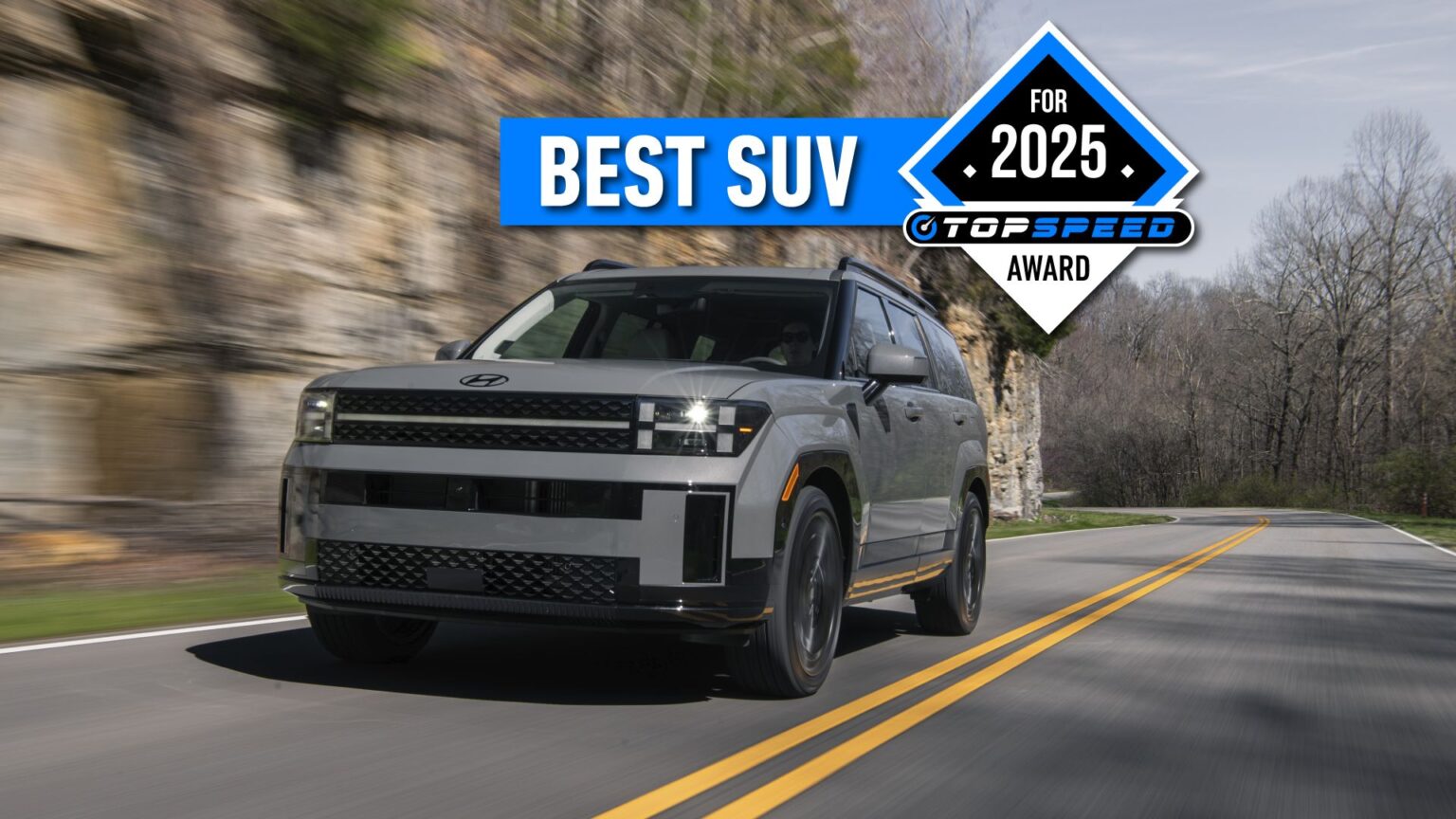It should be no surprise that the Hyundai Santa Fe has earned TopSpeed’s coveted SUV of the Year award. For the past decade, the South Korean automaker has been killing the game in the mainstream automobile segments. Canvas the interwebs and you’ll see that we’re not alone in this opinion. Not only did another Hyundai, the Palisade, win our SUV of the Year award back in 2022, but the previous generation Santa Fe even landed in first place on our annual 10 Best Midsize SUVs list for 2023.
Spacious and well-priced, between about $35,000 and $48,000 all-in, the Santa Fe makes a case for itself against popular SUV offerings in the midsize segment. We like the Hyundai offering a bit better than many family vehicles thanks to clever packaging and overall value.
“It looks like a Land Rover, it’s built like a BMW and priced like a Hyundai. Need I say more?”
– William Clavey, TopSpeed Editor-At-Large
But because of its standard three-row seating, competitive cargo space, and attractive pricing, Santa Fe can be cross-shopped against offerings from Toyota, GMC, Mazda, and Honda, to name a few. High praise, but that’s what it takes to become our Best SUV for 2025.
In order to determine the best vehicle in this category for 2025, our in-house experts have voted on a number of factors, including but not limited to value for the money, performance, and expected reliability and safety. The aggregate review score you see in the display card below is indicative of the average score (rated 1-10) between these factors and is based on real-world experience. Further information regarding our methodology of rating vehicles can be found on TopSpeed’s methodology page.
About Winning Vehicle
The Santa Fe excels in most areas we pay attention to when it comes to family-focused SUVs. Better still, Hyundai’s attention to detail is evident in the vehicle’s execution. For instance, the C-pillars feature hide-away handles (on the XRT and Calligraphy trims) that make accessing the roof rails for top-mounted accessories effortless. That’s a feature that makes you wonder, “Why didn’t anyone think of this before?”
Another innovation is the Santa Fe’s in-dash UV-C-based sterilizer tray inside the glove compartment, which utilizes ultraviolet light to sanitize personal belongings, such as smartphones or wallets, from pathogens.
Contributing to the Santa Fe’s sprightly performance and mature on-road manners is its 277-horsepower turbocharged 2.5-liter four-cylinder engine. While a turbo 1.6-liter hybrid powertrain is also available, we appreciate the zest offered from the bigger mill. Combined with excellent ride and handling characteristics, and luxury-like levels of refinement, the Santa Fe’s character stands out from the SUV crowd.
|
Model |
Hyundai Santa Fe (Gas) |
Hyundai Santa Fe Hybrid |
|---|---|---|
|
Engine |
2.5-Liter Turbocharged Inline-Four |
1.6-Liter Turbocharged Inline-Four w/ Electric Motor Assist |
|
Transmission |
Eight-Speed Dual-Clutch Automatic (DCT) |
Six-Speed Automatic |
|
Horsepower |
277 HP @ 5,500 RPM |
238 HP @ 5,500 RPM |
|
Torque |
311 LB-FT @ 4,000 RPM |
271 LB-FT 1,500–4,500 RPM |
|
Driveline |
Front-Wheel or All-Wheel Drive |
Front-Wheel or All-Wheel Drive |
|
Fuel Economy (Combined) |
23-24 MPG |
34 MPG |
The Hyundai goes over surface imperfections with a firm, yet compliant demeanor, while well-controlled body motions and damping keep things civil and composed in the bends. It’s also very effortless to maneuver, whether in a parking lot or on the open road. As a whole, the Santa Fe is smartly executed and well-rounded — the complete package for most SUV shoppers.
The Runner-Up: 2025 Toyota Land Cruiser
The Toyota Land Cruiser arrived this year, bringing a much-needed overhaul to the Japanese automaker’s iconic nameplate. It replaced the previous generation Land Cruiser that had been with us since 2008. In addition to a completely new platform, powertrain, and design, the new Land Cruiser also ushered in a significant platform change.
The most notable is the fact that our new North American-spec Land Cruiser breaks a decades-long tradition. It is a federalized version of the smaller Land Cruiser Prado (which we also got as earlier versions of the Lexus GX). Toyota chose to offer a smaller LC in this generation to broaden its appeal and reduce cost, while still holding close to the nameplate’s reputation for off-road ability. Mission accomplished.
With Toyota’s latest turbocharged 2.4-liter hybrid powertrain, the new Landie can still tow up to 6,000 pounds. And, it’s still equipped for wilderness adventures in areas where most other vehicles would double back. In short: still very much a Land Cruiser at heart. While the Toyota couldn’t quite beat the overall value, versatility, and economy, we loved in the Hyundai Santa Fe, it still makes for a worthy runner-up.
Read the full article here


